New Female Engineer Statue to Inspire Women— Past, Present, and Future—to Embrace Engineering
“There's a lot of power to her presence.” – Angie Wolters, Associate Director for Women in Engineering
May 30, 2017
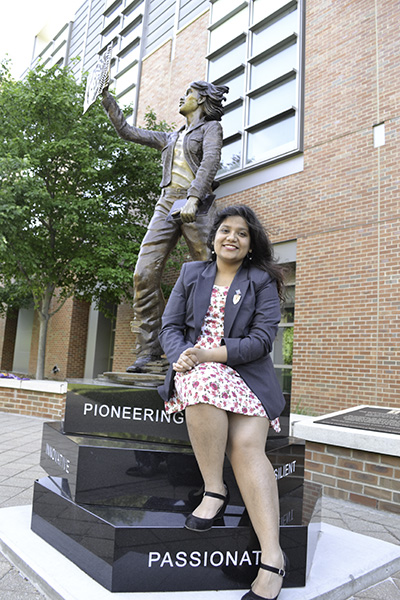
ECE graduate student Sakshi Srivastava, by the Quintessential Engineer
Confident. Passionate. Intelligent. Courageous. Innovative. Resilient. Pioneering. Successful. Inspirational. These character traits describing Illinois’ women engineers are emblazoned on the platforms which support the Quintessential Engineer, Illinois’ newest statue: a female engineer. Unveiled on April 28, 2017, the statue, located just east of MNTL, was four years in the making. While Engineering grad student Sakshi Srivastava is quick to credit Texas Instruments, artist Julie Roblatt Amrany, and the many folks across campus who helped to bring it about, it was Srivastava who first dreamed of a statue to serve as a role model for young women. And it was Srivastava's courage, confidence, and determination (plus a little help from her friends) that helped that dream become a reality.
Why did Srivastava decide we needed a statue of a woman engineer on campus?
“I think it is nothing new when it comes to seeing how few women are enrolled in the College of Engineering…I think even in general in the STEM fields the numbers are not very good,” Srivastava explains.
She recalls writing a paper her freshman year on the underrepresentation of women in the science community. One of the things she discovered was that “Women don’t have many role models, hence young girls don’t see themselves as being in the STEM fields, “she says. “That could be a reason that holds them back from moving forward or considering STEM as a possible career choice. I think the statue can help young women see themselves in engineering, and that was the motivation behind why we should get the statue.”
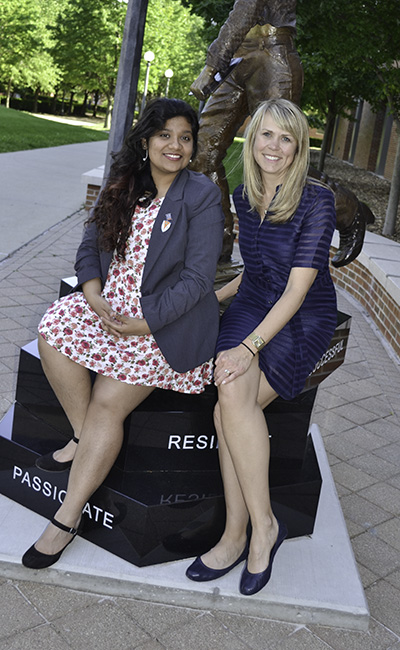
Srivastava and Wolters by the Quintessential Engineer.
A shortage of female role models was never an issue for Srivastava. As a little girl in India, she had some great ones. Her mom was a doctor. Her sister was an engineer. Also, she attended an all-girls school. “So I think I always had women to look up to, and I never had that issue of not having role models in my life."
Srivastava, who got her undergrad degree in ECE (Electrical and Computer Engineering) at Illinois, and is currently working on a Master’s in ECE, got the idea of doing a statue four years ago—the summer after her sophomore year. She said to herself, “‘Let’s do something. Let’s do something...Oh, let’s get a statue!’”
So in July of 2013, she started the ball rolling. She sent Dean Susan Larson an email, asking about the possibility of having a statue of a woman engineer on campus.
“We were like, ‘Yea, that’s great,’ recalls Angie Wolters, Associate Director for Women in Engineering. ‘How would we do this?’ So the conversations ensued.”
The idea initially was to do a statue near the new ECE Building, but decisions regarding art had already been made. So Srivastava started an online petition to see if there would be support.
Next she met with student senator, Josh Baalman, and calls that, “one of the big steps, because after that, once the Student Senate endorsed it, we went to the Academy Senate, and they sent a resolution to dean.”
Srivastava and Wolters stress that they didn’t bring the statue about all alone. They had a lot of help. For instance, a student committee, comprised of representatives from a diverse group of engineering student organizations helped make many of the decisions about the statue.

Two local girls meet the Quintessential Engineer.
One key decision, according to Srivastava, was to define a target audience. “While the statue is definitely for our current students and graduating students ( many of them took a picture with the statue this graduation), at the same time, the statue is also for young girls who come to EOH. I think that is very important to me, to not only promote women currently in engineering for retention purposes, but also to get young women excited about engineering and the possibility of changing or shaping the future.”
Another important decision was what the statue should look like. Questions for debate included: “What should she look like? What feel do we want her to have? We agreed that there should be movement, and she should looked empowered and dynamic,” Wolters says, and that all decisions—how she might be built, what she might resemble, attributes, what she would wear, where she would be located—were student driven.
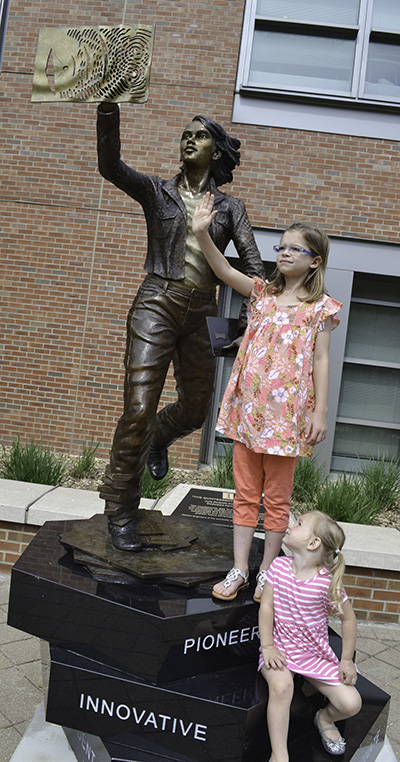
A local youngster emulates the Quintessential Engineer, reaching for the future.
“The student committee helped drive the vision of how she would appear,” Wolters says. “The fact that she is wearing pants vs. a skirt. What she's doing: she's is in motion. You'll see that she's crafted from the bottom up. There are some circuit boards and books that form from her leg; it's like her base of knowledge. That's her past knowledge, her base, and it forms her into the person that she currently is. And she's reaching forward to the future, creating from her finger tips on a plasma screen, where she's creating the future. So her foundation builds her up to then create the future. That was part of the sentiment that came from our discussions with the committee, and then the artist.”
““The artist, Julie Amrany. Julie did a fantastic job,” says Srivastava. What was really striking for me was the books forming part of her leg, which was Julie’s creation. I truly believe that you can't change the future without knowledge.”
According to Srivastava, the committee wrestled with “How would she look as an engineer? How to make her inspiring, empowering, and confident, and someone that young women can look up to and that older women can see themselves in.”
Srivastava says the committee also wrestled with what to put on the base of three hexagons. “Equations? What should symbolize women in engineering, and what would be fundamental to us? Again, it was the student committee that said, 'Why don't we put words there?'
So the committee came up with the nine words. “Each hexagon has three words, and it follows the journey of an engineer—how first you need to be confident and passionate, and intelligent to be an engineer. Then the second step is that you innovate. Eventually you become successful, inspirational. And you find resilience, because you’ve failed too…"Which is super cool. Because how I interpret that is you need knowledge and you need excellent character,” she explains.
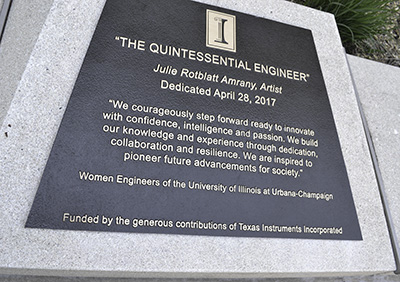
The plaque
And behind the statue is a plaque (see the image to the right) which echoes the character traits on the statue.
Where's the statue located? They found the perfect spot: a brick alcove just east of the Micro Nano Technology Lab on Bardeen Quad, which had been crying out for something since a previous renovation. “It was meant to be,” Srivastava exults, “because that little alcove was already there. It's so beautiful.”
Key in procuring the statue was the Administrative Committee. Led by John Kelly, an Engineering Advancement Officer, it was comprised of folks from across campus, such as those from Facilities and Services in charge of art and architecture.
Wolters calls this type of ‘grass-roots” initiative a unique situation, so this committee was key: “There really aren't that many projects like this that happen on campus, where you're just starting from scratch...So we were kind of in uncharted territory. A lot of work was done by the Administrative Committee.”
In chosing who should make the statue, the committee had to look no further than upstate sculptor Julie Roblatt Amrany, who, along with her husband, created the famous statue of Michael Jordan at Chicago’s United Center. Wolters commends the committees’ decision to hire Amrany, calling it “the perfect choice. We have a female artist, who is a woman, who is very passionate about the STEM fields.”
However, in the four years it took the make the statue a reality, it wasn’t always smooth sailing. For example, there was pushback: people with whom they interacted—and not just men—couldn’t see the need. “Sometimes when people come from a place of privilege, like me, having a role model throughout,” Srivastava says, “it is difficult to see how other women do not have that privilege. I think that could have been a reason why certain people couldn’t see the point of the statue.”
Wise beyond her years, Srivastava says they drew upon negative feedback to strengthen their argument: "Because I think the best way to pacify your critics is to actually listen to them.”
While she admits that even when the feedback was “really hard to read through because it’s rude or it’s harsh, or just mean, there could be something that would help us make our argument robust, so that if someone else asks that question, then we're prepared.”
Her motto was, “It's your choice how you use it, and I think how I tried to use it was to be like, 'Ok, thank you. That was helpful. Ha! Now my argument is stronger.”
So Srivastava considered the feedback, because while the idea for the statue originated with her, she doesn’t claim ownership of it. “Because everybody has their opinion, and this a student project. This is not my statue. It is not Angie’s statue. It is not even Women in Engineering’s statue. It is our statue. It is the students’ statue.”
One sentiment they had to address was related to Grainger Bob. In fact, this reporter, at least a year or more ago, had heard the rumor that Bob was getting a girlfriend—there was to be a female counterpart.
Srivastava rejects that notion: “While it's easy to think of the statue as a counterpart—the word has been used a couple of times, the idea is that it was never meant to be there because of Bob, even though there might have been times when people might have talked about it as a counterpart.”
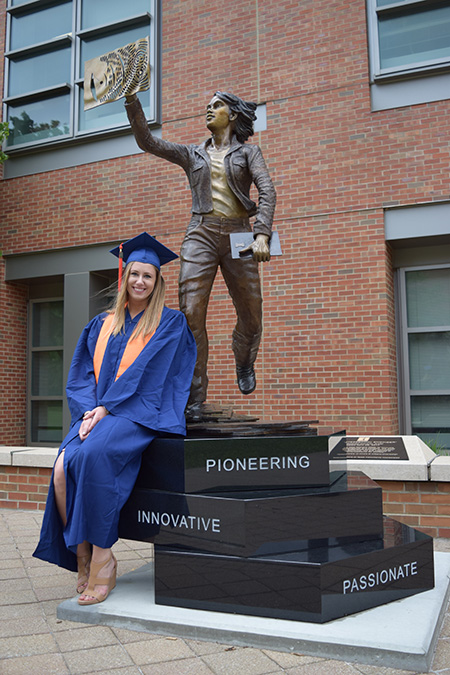
Recent Illinois engineering graduate Lara Flasch gets a graduation photo by the Quintessential Engineer. (Image courtesy of Michelle Rice.)
While the two admit that it’s easy to draw the comparison and say, 'Oh, this is our rebuttal to Bob,” Wolters says, “It isn't necessarily the true sentiment of the message that we want going forward. It’s more about the inspiration.”
Wolters envisions that the statue will serve as a multi-generational nexus, providing the opportunity to “recognize the alums that came before us that worked so hard to achieve their goals, and now they’re out making differences using their engineering skills to make the world a better place. And then we have our current students here feeling supported and that this community is one in which they belong and can achieve in. And that the younger students as they visit, like Sakshi said, for EOH, or they're here during summer camps, that they see themselves represented in a way that they can identify with and be inspired from. So that’s her value.”
To people who asked, "'Is it because of Bob?' Srivastava says, "Then I was like, 'No, it's because we don't have women.’”
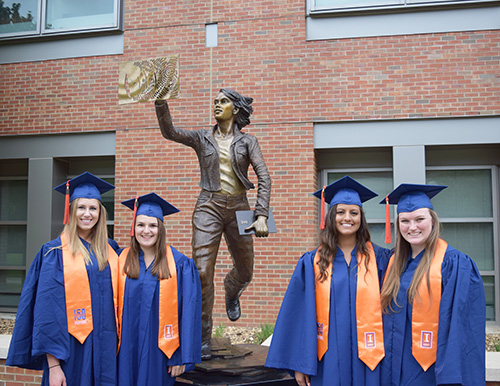
Four Illinois engineering grads get a photo with the Quintessential Engineer during the May 2017 graduation. (Image courtesy of Michelle Rice.)
Another issue that cropped up to muddy the waters as to their motivation behind the statue was that it was a comparative hook, another statue to take pictures with, like how students take pictures with Bob and Alma Mater during graduation.
“It's easy even for Angie and I to do that,” Srivastava admits, “and we have thought of it in terms of, 'People can take pictures with her the way they take them with Bob.’ But it was never the motivation behind it, and it's very important to draw the difference between the two…It is only from the point of view of giving people a hook, but not with the intention of saying that’s our motivation. It was always about, 'We need more women in engineering.'”
But while they encountered pushback, they also got lots of support. Says Srivastava, “Sometimes it’s easy to focus on the negative things, but what kept us going was knowing that there was support...It wasn't just negative comments. There were people, and there were women and men who were willing to help us get the statue.”
IAlong with the many women and men on campus who helped make the statue a reality was Texas Instruments, who provided the funding, and for whom both Wolters and Srivastava have high praise.
“In my remarks at the dedication,” Wolters recalls, “I specifically said that other corporations could look at Texas Instruments as an example of the type of corporation that gives of their time, talent, and treasures to truly support diversity efforts.”
She goes on to cite Women in Engineering activities Texas Instruments has funded to increase recruitment of women: freshmen orientations, technical workshops, professional development luncheons for students.
“At the statue dedication,” she continues, they provided an announcement of scholarships for ten women in electrical and computer engineering, and then of course the statue. So they have truly shared of their resources in a way to make a difference in the diversity of our engineering population…They care about this pipeline of students finding their way into these disciplines of electrical engineering,” adds Wolters. “They've truly shared and championed efforts that a lot of companies speak of, but they've given.”
Srivastava also applauds Texas Instruments, whom, she says “genuinely cares about 50% of the world that tends to get ignored.”
How rewarding was it for Srivastava to see her dream finally become a reality? “I feel blessed,” she admits. “I don’t know if there are other schools in the world where you can do this with one idea, one student starting it, but I felt blessed to be surrounded with people in a school where student voices truly matter and people are willing to put their time in making something like this happen. Angie, Dean Renee, and Dean Larson have been a part of it from almost the very first day, and after that we had student senators. It brought north of Green and south of Green together, in a way.”
She commends the people on campus who helped, calling them people who would listen to you when you have something to say, Dean Cangellaris, and Professor Sanders, everybody on the administrative committee, for example. They are all busy people. For me it was amazing that this thought in my head, this idea, was actually being considered and people were putting their heart into this.”
Her greatest reward, of course—seeing young women interact with the statue: “Nothing is like seeing young women taking a picture with that statue. I cannot wait for EOH or summer camps to happen because those pictures are going to be nice.”
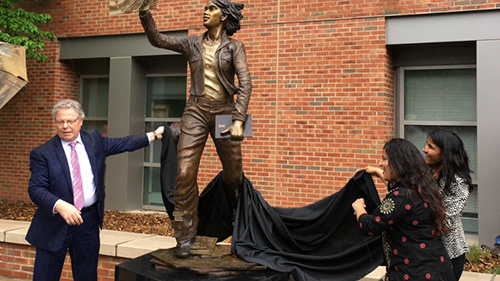
Left to right: Dean Cangellaris, the Quinessential Engineer, Sakshi Srivastava, and artist Julie Rotblatt-Amrany, during the unveiling. (Image courtesy BTN Network
A final anecdote: It was raining really hard the day the statue was unveiled. According to Wolters, “Dean Cangellaris said, 'The statue's right out there. I'm not going to unveil a picture of the statue…No matter what, we're going out there!' And it was pouring! It was raining really hard.” So, many female engineers at the dedication, including Srivastava and Wolters, trooped out to unveil Quin, despite the deluge—a perfect example of their courage and resilience in the face of a storm.
But whether they opted to get soaked or not, for the women engineers who attended the dedication, it was an emotional moment. “There were lots of people that teared up,” Wolters reports. “Some of our women faculty, Cinda Heeren in CS, she teared up. I did, Dean Larson did. There's a lot of power to her presence."
Story and photos (unless noted) by Elizabeth Innes, Communications Specialist, I-STEM Education Initiative
More: Engineering, Student Spotlight, 2017
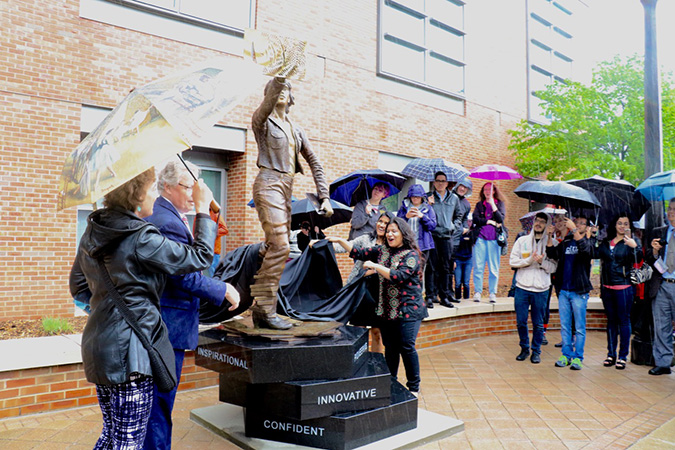
Quinessential Engineer statue unveiled at the dedication. (Image courtesy of Brian Bauer, The Daily Illini.)













.jpg)
















